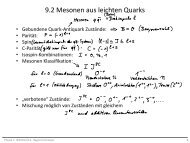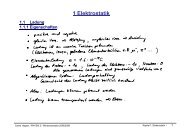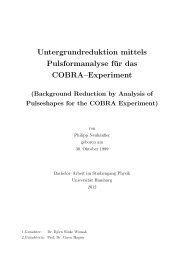Setup of a Drift Tube Muon Tracker and Calibration of Muon ...
Setup of a Drift Tube Muon Tracker and Calibration of Muon ...
Setup of a Drift Tube Muon Tracker and Calibration of Muon ...
You also want an ePaper? Increase the reach of your titles
YUMPU automatically turns print PDFs into web optimized ePapers that Google loves.
Table 5.8: Spatial resolution <strong>of</strong> the Borexino global muon tracking. The results getbetter for high energetic muons. Also, taking only IV muons (nhits>7000) improvesthe resolution.Value Cut σ [m]∆y - 0.963∆z - 1.125∆y p > 50 GeV 0.513∆z p > 50 GeV 0.828∆y p > 50 GeV, nhits>7000 0.377∆z p > 50 GeV, nhits>7000 0.553almost perpendicularly. Fig. 5.30 shows the intersections <strong>of</strong> muons within this planeas reconstructed by both the OPERA detector (black dots) <strong>and</strong> Borexino (red dots).The depiction resembles a view along the CNGS beam direction. Most muons travelin a direction close to the CNGS beam axis. One can clearly recognize both theBorexino sphere <strong>and</strong> the shape <strong>of</strong> the OPERA detector in the muon light.For a more qualitative analysis, the differences <strong>of</strong> the y <strong>and</strong> z coordinates forboth track reconstructions are taken into account. The distributions <strong>of</strong> ∆y <strong>and</strong> ∆zare shown in Fig. 5.31. Besides the spatial resolution one can also deduce a possiblemisalignment <strong>of</strong> both detectors from these values. A shift in y <strong>and</strong> z simply movesthe mean value <strong>of</strong> the corresponding distributions. Due to the small inclinationangle <strong>of</strong> ∼ 3.5 ◦ <strong>of</strong> a typical rock muon track <strong>and</strong> the large distance <strong>of</strong> approximately60 m between the detectors, the method is not sensitive to a possible shift in x. Thedistribution could be fitted by a Voigtian, i.e. a convolution <strong>of</strong> a Gaussian <strong>and</strong> aBreit-Wigner distribution. The spatial resolution is then given by the FWHM/2.35.An even larger dependency <strong>of</strong> the muon’s momentum can be observed for thespatial resolution as can be seen in Fig. 5.31. The results are much improved by onlyconsidering muons that passed the Borexino inner vessel (nhits>7000 in Borexino).All values are summarized in Tab. 5.8. Comparing the results to the values obtainedfrom the CMT analysis shows a good agreement for all trackings.5.6 Future AnalysisThe presented analysis shows the basic functionality <strong>of</strong> both the CMT <strong>and</strong> the Borexinotracking. Once the CMT trigger is replaced <strong>and</strong> enough statistics are gatheredfor a better calibration, the analysis <strong>of</strong> common events will improve significantly. Itis foreseen to include the CMT data directly in the Borexino reconstruction. Oncethe CMT yields satisfactory results, further studies on the Borexino tracking canbegin. The reason for different results <strong>of</strong> the three Borexino trackings can be investigatedwhen the true track is known. CMT tracks that go through Borexino withouta Borexino track reconstruction can be used to identify why no reconstruction wasdone <strong>and</strong> thus improve the Borexino tracking efficiency.97





